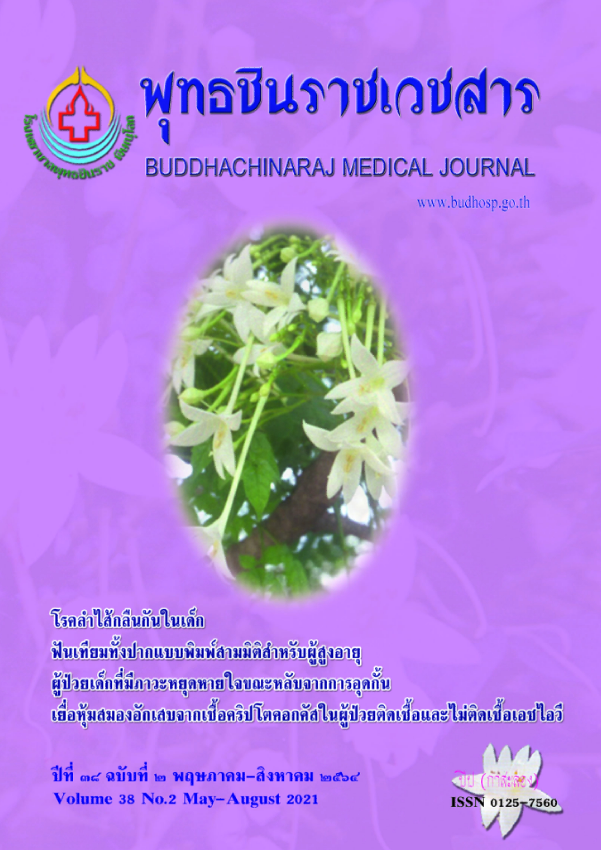ความชุกของการแพ้สารก่อภูมิแพ้ในอากาศในผู้ป่วยเด็กโรคภูมิแพ้ทางเดินหายใจ จากการทดสอบโดยการสะกิดผิวหนัง
ความชุกของการแพ้สารก่อภูมิแพ้ในอากาศในผู้ป่วยเด็กโรคภูมิแพ้ทางเดินหายใจ
คำสำคัญ:
โรคภูมิแพ้ทางเดินหายใจ, การแพ้สารก่อภูมิแพ้ในอากาศ, การทดสอบโดยการสะกิดผิวหนังบทคัดย่อ
โรคภูมิแพ้ทางเดินหายใจส่งผลต่อคุณภาพชีวิตของผู้ป่วย การหลีกเลี่ยงสารก่อภูมิแพ้ทำให้อาการดีขึ้น การศึกษาแบบวิเคราะห์นี้มีวัตถุประสงค์เพื่อประเมินความชุกของการแพ้สารก่อภูมิแพ้ในอากาศในผู้ป่วยเด็กโรคภูมิแพ้ทางเดินหายใจจากการทดสอบภูมิแพ้ทางผิวหนังและเปรียบเทียบปัจจัยที่เกี่ยวข้องกับการถูกกระตุ้นจากสารก่อภูมิแพ้แต่ละชนิด โดยศึกษาข้อมูลย้อนหลังระหว่างวันที่ 1 มกราคม พ.ศ. 2559 ถึงวันที่ 31 ธันวาคม พ.ศ. 2563 จำนวน 524 คน อายุเฉลี่ย 7.9 ปี พบผู้ป่วยที่ผลการทดสอบฯ อย่างน้อย 1 ชนิดให้ผลบวก 353 คน (ร้อยละ 67) ความชุกของการแพ้ไร ฝุ่น แมลงสาบ เกสรหญ้า ขนแมว ขนสุนัข และสปอร์ของเชื้อราร้อยละ 90, 64, 38, 28, 13และ 13 ตามลำดับ โดยพบผลบวกมากเมื่ออายุที่ทดสอบมากกว่า 1 ปี, อาการปานกลาง/รุนแรงหรือนานกว่า 1 เดือนต่อปี, ประวัติภูมิแพ้ในครอบครัว และสัมผัสกับมลพิษในอากาศ ผู้ป่วยที่อาการปานกลาง/ รุนแรงมีโอกาสแพ้ขนสุนัขมากกว่าผู้ป่วยที่อาการน้อย 1.88 เท่า ผู้ป่วยนอนฟูกที่ทำจากใยสังเคราะห์ ใช้เครื่องปรับอากาศ และอาศัยอยู่ในบ้านเดี่ยวพบผลบวกต่อไรฝุ่นลดลง สรุปได้ว่าไรฝุ่นเป็นสารก่อภูมิแพ้ที่พบมากที่สุด โดยอายุที่มากขึ้น มีอาการมาก มีประวัติภูมิแพ้ในครอบครัว หรือสัมผัสกับ มลพิษในอากาศทำให้พบผลบวกมากขึ้น
เอกสารอ้างอิง
2. Bunnag C, Jareoncharsri P, Tantilipikorn P, Vichyanond P, Pawankar R. Epidemiology and current status of allergic rhinitis and asthma in Thailand-ARIA Asia-Pacific Workshop Report. Asian Pac J Allergy Immunol 2009;27(1):79-86.
3. Dick S, Doust E, Cowie H, Ayres JG, Turner S. Associations between environmental exposures and asthma control and exacerbations in young children: a systematic review. BMJ Open 2014;12(4):e003827.doi: 10.1136/bmjopen-2013-003827
4. Tham EH, Lee AJ, Van Bever H. Aeroallergen sensitization and allergic disease phenotypes in Asia. Asian Pac J Allergy Immunol 2016;34(3):181-9.
5. Sakashita M, Hirota T, Harada M. Prevalence of allergic rhinitis and sensitization to common aeroallergens in a Japanese population. Int Arch Allergy Immunol 2010;151(3):255-61.
6. Kongpanichkul A, Vichyanond P, Tuchinda M. Allergen skin test reactivities among asthmatic Thai children. J Med Assoc Thai 1997;80(2):69-75.
7. Trakultivakorn M. Prevalence of allergen skin test positivities in children with asthma and allergic rhinitis at Maharaj Nakorn Chiang Mai Hospital. Thai J Pediatr 2000;39(3):195-203.
8. Oncham S,Tongdee M, Dachaprapapital N, Kafaksom T, Wongsa C, Laisuan W. Prevalence of aeroallergen sensitization from skin prick test in Allergy Clinic at Ramathibodi Hospital. Ramathibodi Med J 2018;41(2):9-15.
9. Tongloh S. Allergen skin test reactivities in children with allergic rhinitis, allergic conjunctivitis, atopic dermatitis and asthma at SurinHospitat. Med J Srisaket Surin Buriram Hosp 2011;26(2):263-73.
10. Wongworapat K, Damrongmanee A, Lao-araya M, Trakultivakorn M. Skin prick test reactivity to aeroallergens among children at Allergy Clinic, Chiang Mai University Hospital. Thai J Pediar2014;53(4):241-51.
11. Wagner N, Rudert M. Sensitivity and specificity of standardized allergen extracts in skin prick test for diagnoses of IgEmediated respiratory allergies. ClinTransl Allergy 2019;9:8. doi.org/10.1186/s13601-019-0248-9
12. Anca MC, Jean B, Pascal D. In vivo methods for the study and diagnosis of allergy. In: Burks AW, editor. Middleton's allergy: principles and practice. 9th ed. Amsterdam, Netherlands: Elsevier Inc; 2019. p.1097-107.
13. Ludger K, Claus B, Oliver P, Sven B, Thomas B, Randolf B, et al. ARIA Guideline 2019: treatment of allergic rhinitis in the German health system. Allergo J Int 2019; 28:255-76. doi.org/10.1007/s40629-019-00110-9
14. Tamasauskiene L, Gasiuniene E, Sitkauskiene B. Translation, adaption and validation of the total nasal symptom score (TNSS) for Lithuanian population. Health Qual Life Outcomes 2021;19:54. doi.org/10.1186/s12955-020-01659-8
15. Alexander LK, Lopes B, Ricchetti-Masterson K, Yeatts KB. Cross-sectional studies: ERIC notebook. UNC CH Department of Epidemiology [Internet]. 2015 [cited 2021 Aug 9]. Available from: https://sph.unc.edu/wp-content/uploads/sites/112/2015/07/nciph_ERIC8.pdf
16. Bantz SK, Zhu Z, Zheng T. The atopic march: progression from atopic dermatitis to allergic rhinitis and asthma. J Clin Cell Immunol 2014;5(2):202. doi: 10.4172/2155-9899.1000202
17. Centers for Disease Control and Prevention. Preschoolers (3-5 years of age) [serial on the Internet]. 2021 Feb 22 [cited 2021 Aug 15]. Available from: URL: https://www.cdc.gov/ncbddd/childdevelopment/positive parenting/preschoolers.html
18. Sofranac M. Correlation between allergic rhinitis, asthma, and atopic dermatitis in children. Pediatrics 2008;121(Suppl 2):S91. doi: https://doi.org/10.1542/peds.2007-2022G
19. Pearce N, Pekkanen J, Beasley R. How much asthma is really attributable toatopy?. Thorax 1999;54(3):268-72.
20. Arshad SH, Tariq SM, Matthews S, Hakim E. Sensitization to common allergens and its association with allergic disorders at age 4 years: a whole population birth cohort study. Pediatrics 2001;108(2):E33. doi: 10.1542/peds.108.2.e33
21. Visitsunthorn N, Chaimongkol W, Visitsunthorn K, Pacharn P, Jirapongsananuruk O. Great flood and aeroallergen sensitization in children with asthma and/or allergic rhinitis. Asian Pac J Allergy Immunol 2018;36(2):69-76.
22. Phoomyotha K, Prasamphanich T. Study of skin prick test in children with allergic diseases. J Prapokklao Hosp Clin Med Educat Center 2003;20(1):5-12.
23. Ngamphaiboon J, Chatchatee P, Thongkaew T. Cow's milk allergy in Thai children. Asian Pac J Allergy Immunol 2008;26(4):199-204.
24. Herr M, Just J, Nikasinovic L, Foucault C, Le Marec AM, Giordanella JP, et al. Risk factors and characteristics of respiratory and allergic phenotypes in early childhood. J Allergy Clin Immunol 2012;130(2):389-96.
25. Zuraimi MS, Tham K-W, Chew F-T, Ooi PL, Koh D. Home air-conditioning, traffic exposure, and asthma and allergic symptoms among preschool children. Pediatr Allergy Immunol 2011;22(1 Pt 2):e112-8.
26. Zhan X, Li C, Xu H, Xu P, Zhu H, Diao J, et al. Air-conditioner filters enriching dust mites allergen. Int J Clin Exp Med 2015;8(3):4539-44.
27. Schata M, Jorde W, Elixmann JH, Linskens HF. Allergies to molds caused by fungal spores in air conditioning equipment. Environ Int 1989;15(1-6):177-9.
28. Kidon MI, See Y, Goh A, Chay OM, Balakrishnan A. Aeroallergen sensitization in pediatric allergic rhinitis in Singapore: is air-conditioning a factor in the tropics?. Pediatr Allergy Immunol 2004;15(4):340-3.
29. Ownby D, Johnson CC. Recent Understandings of Pet Allergies 2016;27(5):F1000-108. doi: 10.12688/f1000research.7044.1
30. Li CH, Sayeau K, Ellis AK. Air pollution and allergic rhinitis: role in symptom exacerbation and strategies for management. J Asthma Allergy 2020;26(13):285-92. doi:10.2147/JAA.S237758






